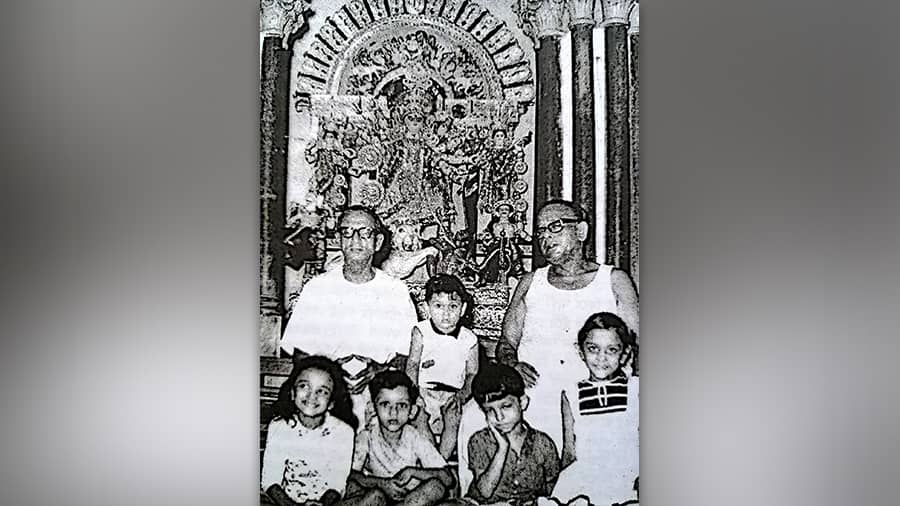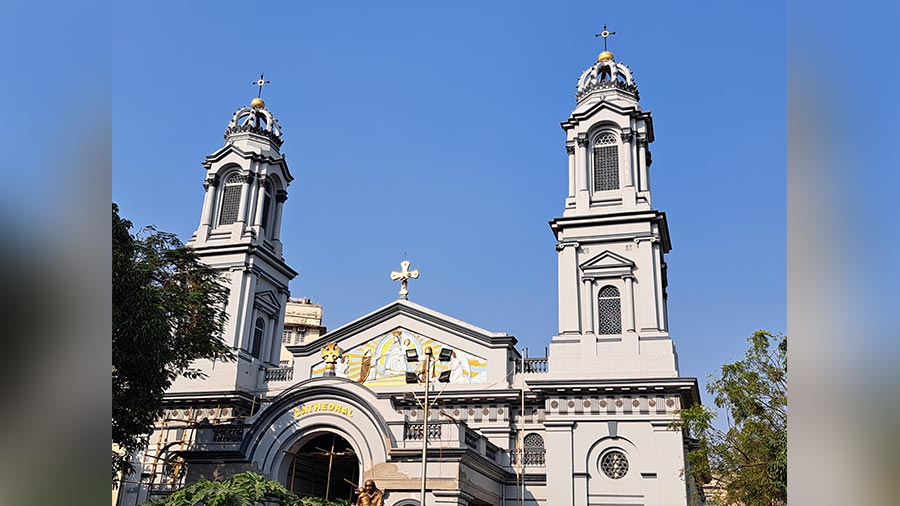The house of Chandranath Chatterjee near Shahid Khudiram Metro station on the north-south corridor is a veritable treasure box to say the least.
Each of its rooms, staircase landings and every possible nook and cranny is stashed with pieces of a bygone era. Right from a century-old drama poster of Star Theatre to an original photograph of Swami Vivekananda, thanks to his late father, Chandranath’s house is nothing less than a collector’s dreamland.
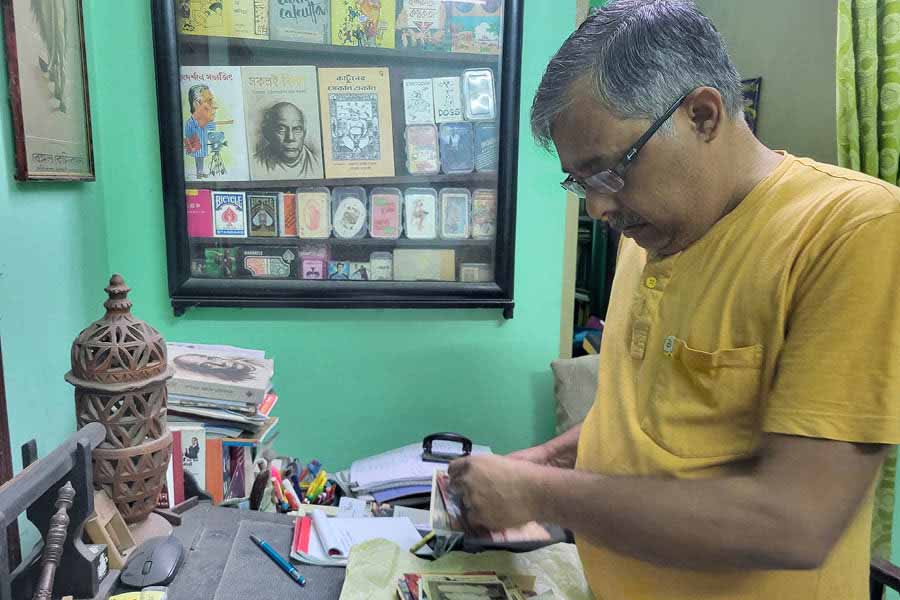
Chandranath Chatterjee sifts through his rare collection of rare documents, books, paintings, posters, vintage objects and artefacts at his Garia house.
Chandranath is the youngest son of Bimal Chandra Chatterjee, the man who was an indispensable character artist in many films directed by Satyajit Ray to Mrinal Sen. He was also a legendary figure as collector of rare documents, books, paintings, posters, vintage objects and artefacts.
The little known fact is that being the younger brother of Nirmal Chandra Chatterjee, he was also an active worker of Bengal’s Hindu Mahasabha in the 1930s to 1950s. This connects Bimal Chandra and his big family to Vinayak Damodar Savarkar, an immortal man in Indian politics who 58 years after his death still comes to the centre-stage of many politics for his contested legacy.
Chandranath recalls his father’s profound respect for Savarkar with whom he spent many golden moments. Though Chandranath never met Savarkar, his much older cousins and siblings have fond memories of him.
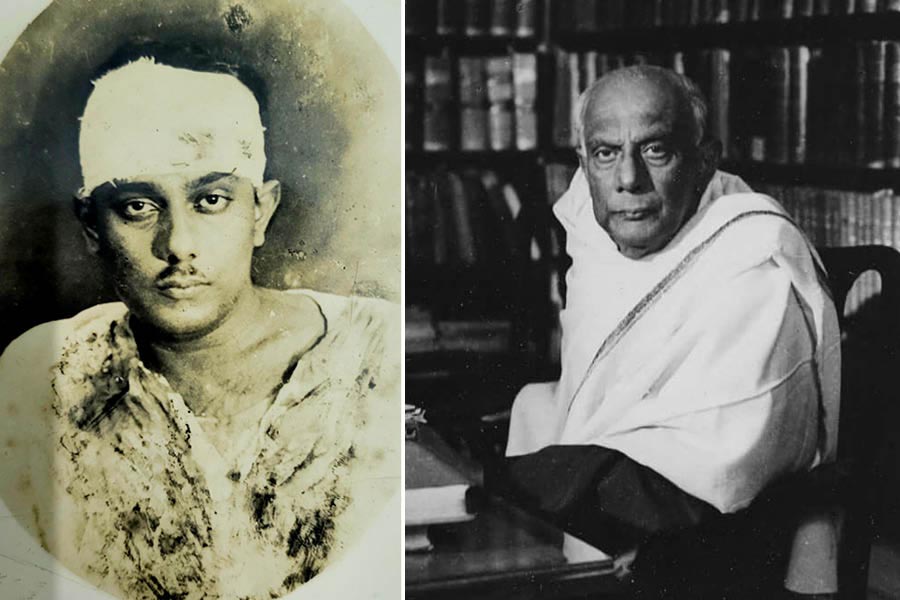
A young Bimal Chandra Chatterjee as a member of the Hindu Mahasabha and (right) at an advanced age
After his unconditional release in 1937, Savarkar came to Calcutta in February 1939 and took the hospitality of Nirmal Chandra (NC) Chatterjee’s palatial house at 5 Theatre Road (now Shakespeare Sarani). The huge bungalow was later used as British Council’s library and now is the regional office of a reputable bank.
Savarkar’s short stay in this house in 1939 may be an omitted chapter of history but for all the surviving members of Chatterjee family who all are now aged more than 85 years, the memories of Vinayak D Savarkar memories are fresh.
Memory is not the only footprint that Savarkar left in this family. This family still preserves many tangible and intangible memorabilia of Savarkar, which are exceptional and next to none.
“Savarkar convinced my father to marry and settle down in life,” says Chandranath, the younger son of Bimal Chatterjee. Bimal babu wrote in his memoirs about the days when he was instructed by his elder brother NC Chatterjee to go and receive Savarkar at the station. It was February 16, 1939. Though in his memoirs, he mentioned the station as Sealdah, it was actually Howrah station where he received Savarkar.
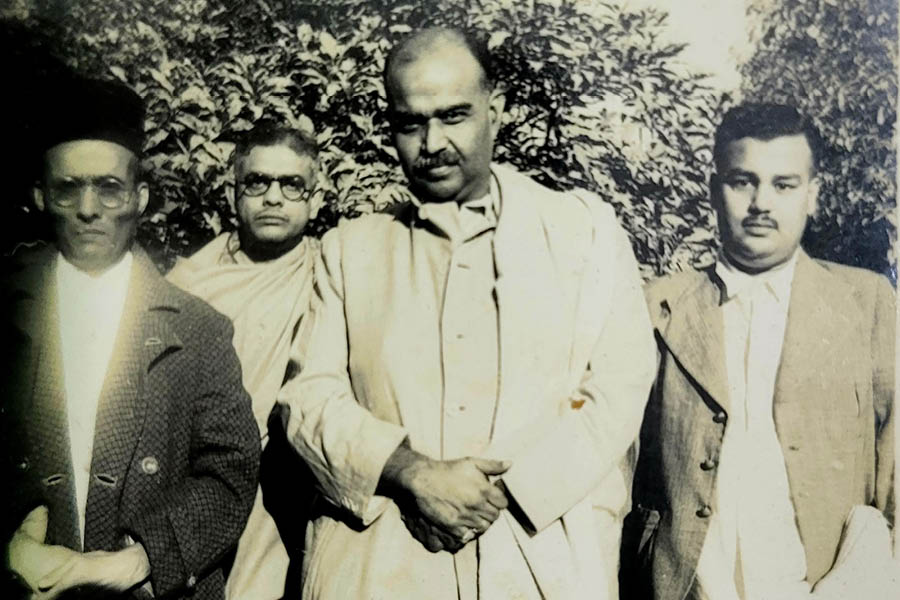
Vinayak D Savarkar and (centre) Syama Prosad Mookerjee in 1939. Photograph by Bimal Chandra Chatterjee
Bimal, then an active worker of Hindu Mahasabha, received him at the station and took him to 5 Theatre Road, a huge walled bungalow with lawns owned by his elder brother NC Chatterjee.
It was Bimal himself who arranged a grand procession of Sikh cavalcade with swords in hands that led Savarkar from Howrah station to Theatre Road. He also arranged legendary singer Pandit Onkarnath to sing Vanda Mataram before Savarkar. In a nutshell, the entire event of Savarkar’s arrival at the station was organised by young Bimal.
Bimal wrote later that the thin-structured short-heighted Savarkar used to talk less but used to talk very convincingly. After lunch, he did not take rest, rather started talking to young members of the family. Bimal asked him directly how did he jump into the sea from the port hole of the ship though his hands were chained. Did he not get scared when bullets were raining on him while he swam towards the shore of France? Savarkar replied that a revolutionist does not know the fear of death. “I fooled them by doing various strokes of swimming and finally reached the shore of France in an exhaustive state,” said Savarkar. However, the language barrier in France threw him again in the custody of British police, wrote Bimal Chatterjee.
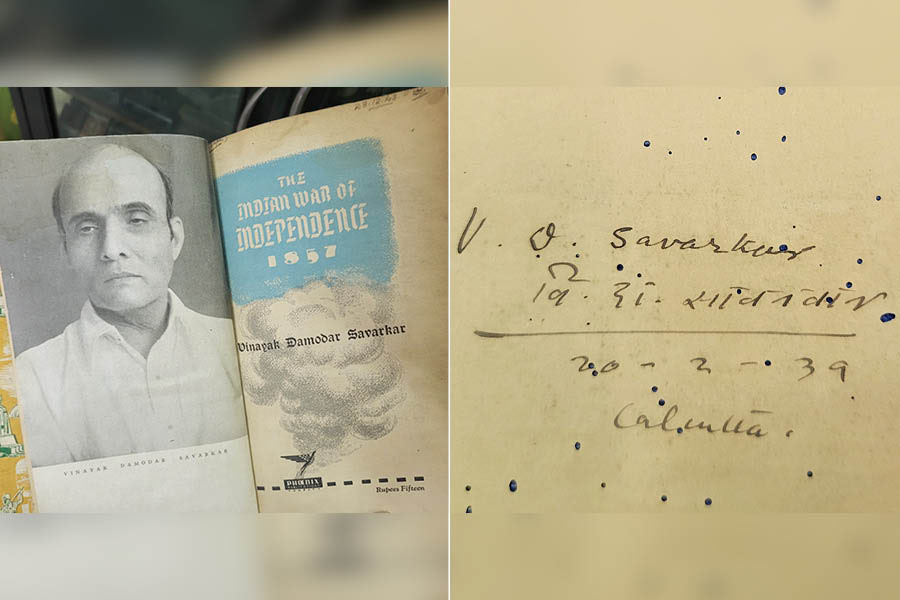
A book written by Savarkar and (right) his signature in English as well as in Hindi.
Chandranath talks about the role of his father and Ashutosh Lahiri, a co-prisoner of Savarkar in the Cellular Jail, to organise a public reception for Savarkar at Calcutta’s Town Hall on February 16, 1939. The hall was packed to its capacity and was graced by Calcutta’s top intellectuals, including Sarala Devi and Suniti Kumar Chattopadhyay. It was presided by Dr Syama Prosad Mookerjee.
“Baba said many a time that the speech delivered by Savarkar at that function was more than extraordinary. My father was so moved by his persona and fiery speech that he later wrote a Marathi named Bhaskar Pandit came to Bengal many years ago to plunder it and now, another Marathi had won hearts of thousands of Bengalis.
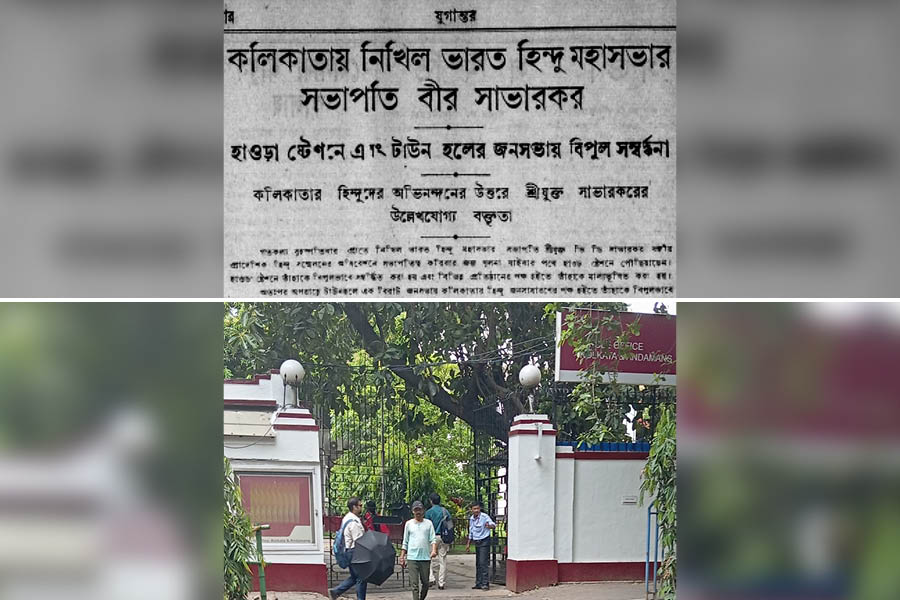
(Top) Screenshot of a Bengali news article reporting Hindu Mahasabha chief Vinayak D Savarkar’s arrival in Calcutta in February, 1939 and (above) the house at 5 Theatre Road (Shakespeare Sarani) at present houses the regional office of a bank. Rabishankar
“The bonding between Baba and Savarkar became too cordial that when my grandmother requested Savarkar to convince my father to marry and he gladly took up the responsibility to explain him the utility of marriage by giving the example of the contribution of his own wife,” narrates Chandranath.
There, at the Theatre Road residence, Bimal took several photographs of Savarkar and out of those, couple of photos are survived. “Here is one where Savarkar and Dr Mukherjee are seen together. It was taken by Baba. He had also photographed icons such as Jawaharlal Nehru, Subhash Chandra Bose, Sardar Vallabhbhai Patel at many occasion.” Chandranath takes a small black and white vintage photo featuring two tallest icons of Hindutva politics out of his folder.
Chandranath also shows an autograph of Savarkar, where he has signed both in English and Marathi. The date given is 20th February, 1939 – Calcutta.
This house also has three oldest editions of Savarkar’s book, all collected by his father. It includes the 1947 edition of The Indian War of Independence: 1857 and 1941 edition of Whirlwind Propaganda. Both the books are believed to be seen by Savarkar himself with his multiple visits to their house.
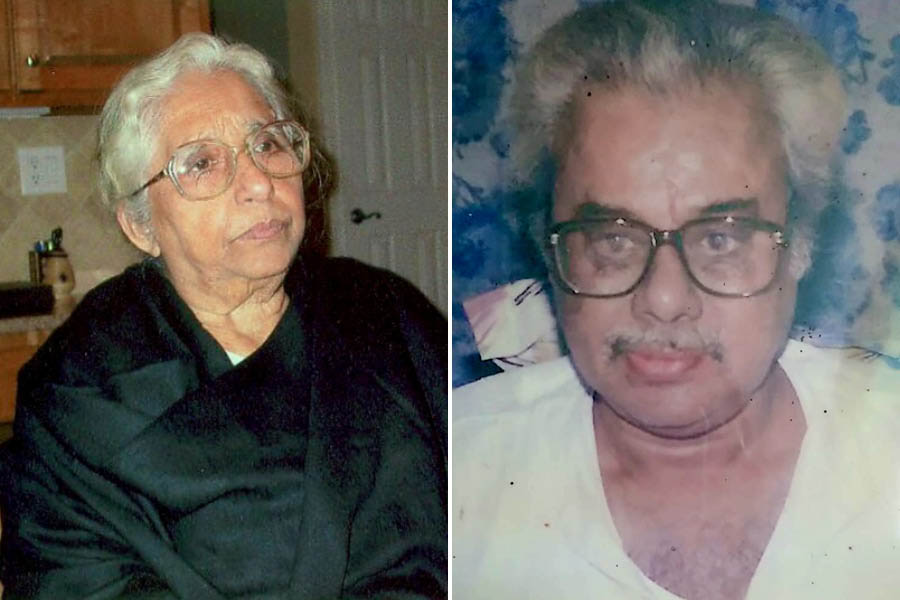
Debrani Mukherjee and (right) Pashupati ‘Shivaji’ Chatterjee, who was nicknamed by Savarkar.
Ninety-eight-year-old Debrani Mukherjee, daughter of NC Chatterjee’s another younger brother, Subodh Chatterjee, now often falls short of memory but she has not forgotten yet her days with Savarkar.
“Ma, do you know Savarkar?” asked her daughter, Sushmita Ganguly. The nonagenarian’s face lit up.
“Yes, he was Veer Vinayak Savarkar, the small structured, fair complexion man but a great soul who came to stay with us at our Theatre Road residence many years ago.”
Debrani born in 1926, was 12 years old, when she saw a great leader coming to their living room and continuously receiving visitors from many walks of lives.
“The period of his stay was like a festival in my uncle’s house. We, the young members, were too excited to see the man though we were not very clear to understand his fame. We only knew that he was a great patriot who had suffered a lot. We used to talk with him in broken Hindi and English. He understood a little Bengali too. He used to hug all of our cousin brothers and sisters, including Habul, who was five to seven years younger to me. Habul’s good name was Somnath Chatterjee, who later became Speaker in the Lok Sabha. Habul, my little brother, used to show his teeth while smiling. We jokingly used to shut his lips before him.”
Savarkar used to exchange small information about our schools and studies. He once asked me how much I have studied. We all youngsters of the family were allowed to sit near him, while he used to keep himself busy with local leaders,” reminisced Debrani.

Earliest editions of books written by Vinayak D Savarkar in the possession of the Chatterjee family.
“He was a very simple man. As far as I know, he was strict about his food habits and used to take mostly vegetarian food, especially cooked by my grandmother, Sailabala Devi. She came to meet Savarkar from our ancestral home at Bhowanipore. We were all very eager to offer any of our services to him like handing over a piece of paper or serving him water, etc. Two massive tents were pitched on the lawn of our house where all throughout the day, many meetings took place. We saw Syama Prosad many a time. He was a classmate of my uncle and a noted educationist,” Debrani stops, after talking for long.
Debrani also has the memory of taking part in a procession with Savarkar. She recalls the evening, when all of them followed Savarkar’s procession in a car. The procession covered Chowringhee area.
Eighty-three-year-old Minakshi Chatterjee saw Savarkar at their ancestral home of 52 Harish Mukherjee Road, when he was back to the city in 1949. “I may be wrong about the years because I was too young,” says Minakshi.
I remember the man clad in a prince coat, dhoti and wearing a black Marathi cap on his head, he was not that tall a man. My father, Bimal Chatterjee, and uncle, NC Chatterjee, were his friends.
Minakshi shares an interesting anecdote. “My brother, Pashupati, was a daredevil from an early age. Once while participating in a rally of Hindu Mahasabha, he rode a horse by jumping on its back with a sword in his hand. As Savarkar noticed him from a distance, he praised the boy and named him after Shivaji. He found his hero, Shivaji, in my brother,” says Minakshi.
Chandranath adds from there that in their family, male members are mostly named after Lord Shiva like Pashupati, Somnath, Chandranath, etc. “So naming my elder brother after Shivaji made no noise in the family, rather we are still proud that a towering persona like Savarkar was so generous to name one of our kids in the family,” signs off the man with a huge collection of rare documents, articles and photographs.
The contested legacy of Savarkar does not work in the Chatterjee family of Bengal.

